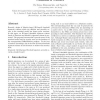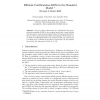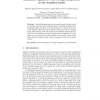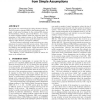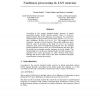100
Voted
IJNSEC
2010
14 years 7 months ago
2010
Recently, design of Identity-based (ID-based) threshold signature schemes which are efficient and provably secure in the standard model has drawn great concerns. In this paper, an...
115
click to vote
TIT
2011
14 years 7 months ago
2011
Abstract. In 1998, Blaze, Bleumer, and Strauss proposed a cryptographic primitive called proxy re-encryption, in which a proxy transforms – without seeing the corresponding plain...
103
Voted
ICISC
2009
14 years 10 months ago
2009
Abstract. We give a direct construction of a certificateless key encapsulation mechanism (KEM) in the standard model that is more efficient than the generic constructions proposed ...
104
Voted
CISC
2009
Springer
14 years 10 months ago
2009
Springer
Sanitizable signatures provide several security features which are useful in many scenarios including military and medical applications. Sanitizable signatures allow a semi-trusted...
INFORMATICALT
2010
14 years 11 months ago
2010
In a fuzzy identity-based encryption (IBE) scheme, a user with the secret key for an identity ID is able to decrypt a ciphertext encrypted with another identity ID if and only if I...
BC
2002
15 years 8 days ago
2002
Hebb's original postulate left two important issues unaddressed: (i) what is the effective time window between pre- and postsynaptic activity that will result in potentiation?...
141
Voted
EUROCRYPT
2010
Springer
15 years 18 days ago
2010
Springer
We investigate the possibility to prove security of the well-known blind signature schemes by Chaum, and by Pointcheval and Stern in the standard model, i.e., without random oracle...
127
Voted
CCS
2010
ACM
15 years 18 days ago
2010
ACM
We provide new constructions of Leakage-Resilient IdentityBased Encryption systems (IBE) in the Standard model. We apply a hash proof technique in the existing IBE schemes of Bone...
NIPS
1997
15 years 1 months ago
1997
Conditioning experiments probe the ways that animals make predictions about rewards and punishments and use those predictions to control their behavior. One standard model of cond...
90
Voted
NIPS
2003
15 years 1 months ago
2003
According to the current standard model, neurons in lateral geniculate nucleus (LGN) operate linearly. There is, however, ample evidence that LGN responses are nonlinear. To accou...
